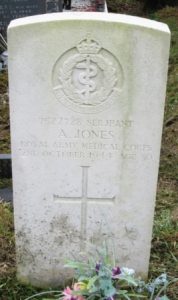Llangyniew is a hamlet and community in Montgomeryshire, situated on a hill inside a bend in the River Banwy, approximately two miles north-east of Llanfair Caereinion. The community includes the hamlet of Pontrobert. The centre of the hamlet contains the Parish Church of St. Cynyw, which dates from between 1450 and 1500, and there is also an Iron Age Hillfort nearby. The men of the community who fell during the Great War are commemorated on the Parish war memorial, situated within the Churchyard, which was unveiled by General Sandbach on Sunday 2 November 1919, and was dedicated by the Archdeacon of Montgomery. The memorial takes the form of a Celtic Cross, with two bronze panels affixed, one with the names of the fallen, and the other a dedication.
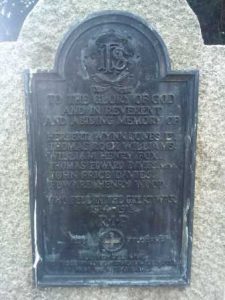
The Great War, 1914-1918
John Price Davies, Private, 203821, Royal Welsh Fusiliers. John was the son of John Evan Davies and Elizabeth Ann Davies, of Minfford, Cefnllwyd, Llangyniew. He worked as a waggoner prior to the war. John enlisted at Welshpool into the 4th (Reserve) Battalion, Royal Welsh Fusiliers on 16 February 1917. After completing his training, he embarked for France at Southampton on 18 August 1917 and disembarked in Rouen two days later, joining the 5th Infantry Base Depot. On 31 August 1917 John was posted to Ypres, joining the 9th Battalion, Royal Welsh Fusiliers, which was attached to 58 Brigade, 19th (Western) Division. The Division had seen heavy fighting during the battle of Messines just two months previously, then enjoyed a short spell in reserve before moving back into the line on 11 September, taking over a section of trenches running from the Ypres-Comines Canal to Belgian Wood. On 20 September the 9th Welsh took part in an attack by the Division, past Hollebeke Chateau, to Hessian Wood. The 9th Welsh alone suffered around 300 casualties during the costly attack. The Division then moved south and wintered in the Cambrai sector, following the closure of the Battle of Cambrai, and was holding a section of the line in the Flesquières Salient. On 21 March 1918 the Germans launched the first of three offensives on to the section of the front running from Flesquières to St. Quentin, and the 19th Division was thrown into desperate fighting as it was pushed back over the coming days. The battered Division was then moved to the Messines sector to rest, but on 11 April became caught up in the second phase of the German offensive, which had been launched along the Lys Valley on 9 April, and again became caught up in desperate fighting. The remnants of the Division were moved south to the Aisne sector to rest and rebuild, but by sheer bad luck, the Germans third, and last, offensive was launched here on 27 May 1918, and the Division was once more caught up in desperate fighting. John was killed near Chamuzy on 14 June 1918. The 20-year-old has no known grave and is commemorated on the Soissons Memorial, France. His brother, Thomas, was killed just four months later.
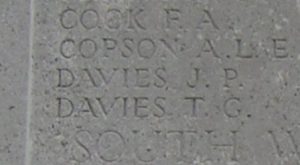
Thomas Edward Davies, MM, Sergeant, 15107, King’s Own Yorkshire Light Infantry. Thomas was the son of John Evan Davies and Elizabeth Ann Davies, of Minfford, Cefnllwyd, Llangyniew. He lived in Wakefield prior to the war and enlisted there into the 6th Battalion, King’s Own Yorkshire Light Infantry soon after the outbreak of war. The battalion formed at Pontefract, before moving to Inkerman Barracks, Woking to join 43 Brigade, 14th (Light) Division. On 21 May 1915 the battalion landed at Boulogne, and proceeded to Flanders, before the entire division took over positions near Locre, south of Ypres. The Division was to see its first action during the Action of Hooge, where it was attacked by the German use of flamethrowers. The Division then fought at the Second attack on Bellewaarde. In July 1916 the Division moved to the Somme, fighting at the Battle of Delville Wood, and then the Battle of Flers-Courcelette, and in March 1917 followed the German Retreat to the Hindenburg Line. May saw the Division at Arras, where it took part in the First Battle of the Scarpe, and later at the Third Battle of the Scarpe, before being sent to Ypres, where it fought at the Battle of Langemarck, the First Battle of Passchendaele and the Second Battle of Passchendaele. By the Spring of 1918 the Division was near St. Quentin, and were hit there by the German Spring Offensive of 21 March, suffering such terrible casualties over the coming days that the Division was withdrawn from the line and placed on the construction of a new defensive line in the rear. On 26 April, the infantry battalions were reduced to a training cadre, and Thomas returned home on leave. He married Lily Elizabeth Jackson, of 4a, Stopford Road, Lewington, London on 4 August 1918, whilst home on leave, but soon afterwards returned to France, joining ‘A’ Company, of the 2nd Battalion, King’s Own Yorkshire Light Infantry, which was attached to 97 Brigade, 32nd Division. On 21 August 1918 the Allies launched a massive offensive along the Western Front, and the 32nd Division was situated near the Amiens to St. Quentin Road when the great offensive was launched, reaching Harbonnières by 25 August. The 2nd KOYLI remained in support near the village of Misery, before crossing the Somme on 5 September, and joining the advance, helping take Trefcon and Villers-Bretonneux over the coming days. By 1 October the battalion had taken the village of Levergies, and began to prepare for an assault on the village of Sequehart, which formed a strong defensive position on the Fonsomme Line. Thomas was killed in action during the assault on Sequehart on the morning of 3 October 1918. The 23-year-old has no known grave and is commemorated on the Vis-en-Artois Memorial, Haucourt, France. Thomas had been awarded the Military Medal, for Bravery in the Field, just prior to his death. His brother, John, had been killed just four months previously.
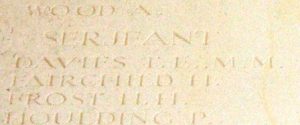
William Henry Fox, Private, 88426, The King’s (Liverpool Regiment). William was the son of Thomas Fox and Martha Ann Fox (nee Owen), of Penybont, Llangyniew. He married Margaret Delia Rowlands at Carno in 1916. William enlisted into the army after this and was initially posted to the East Surrey Regiment. After embarking for France in the winter of 1917, he initially joined the 2/7th Battalion, King’s (Liverpool Regiment), but was then posted to the 4th Battalion, King’s (Liverpool Regiment), which was attached to 98 Brigade, 33rd Division. William probably joined up with the battalion while it was in the Passchendaele Sector, following the closure of the Third Battle of Ypres. On 12 December the battalion was relieved and entrained at St. Jean for Eecke with the 33rd Division, to rest and rebuild. In January 1918 the battalion moved back into the line at Passchendaele, spending the coming weeks rotating between spells in the front line, and spells in reserve, and also supplying working parties. To the south, of 21 March 1918 the Germans launched the first phase of their Spring Offensive, along the section of front running from Croisilles to La Fère. On 9 April they launched the second phase of their offensive along the Lys valley, and broke through the Allied lines. The 4th Kings were training behind the lines at Ambrines when the offensive was launched, and on 10 April was moved by train to Strazeele, to shore up the Allied line, taking up positions at Kemmel and Dranoutre, before advancing to Meteren where the battalion came into contact with the Germans on 15 April, beginning a period of desperate fighting over the coming days until the survivors were relieved on 19 April. On 21 April the remnants of the 33rd Division were inspected at Bavinchove by the grateful French Prime Minister, Clemenceau. The Division moved back into the line in the Dickebusch Lake and Ridge Wood sector on 4 May, and on 8 May the division became the target of a massive German artillery and gas bombardment, suffering heavy casualties before launching a counter-attack on the east side of the lake. William was killed in action during the attack on 9 May 1918. The 23-year-old is buried in Klein-Vierstraat British Cemetery, Belgium.
Herbert Wynn Jones, Lieutenant, Royal Welsh Fusiliers. Herbert was the son of John Morris Jones and Jane Jones, of Mathrafal, Meifod. He was a farmer prior to the war. Herbert enlisted into the Montgomeryshire Yeomanry, but on 1 March 1915 was commissioned as Second Lieutenant into the Welsh Horse Yeomanry. Herbert did not embark for Gallipoli with the Welsh Horse, but remained in England until being transferred to the Machine Gun Corps, and embarked for France on 16 October 1916, joining the 1st Machine Gun Squadron of the 1st Cavalry Division. Herbert was badly wounded following the launching of the German Spring offensive on 21 March 1918, and died of his wounds on 24 March 1918, aged 30. He is buried in Rosieres British Cemetery, France. A memorial Litany desk, dedicated to Herbert, was unveiled in the Church on the same day that the village war memorial was unveiled.
Thomas Rock Williams, Private, 35340, South Wales Borderers. Thomas was the son of Thomas and Ruth Williams of Plascoch, Llangyniew. He enlisted into the South Wales Borderers at Welshpool at some time in 1915, and was posted to the 12th Battalion, South Wales Borderers, which was attached to 119 Brigade, 40th (Bantam) Division. This Division was formed between September and December 1915, composed of bantam units and others which had a mixture of regulation-height and shorter men. Weeding out of very under-sized or unfit men delayed the training programme, and it was not until late Spring 1916 that the Division was ready to proceed on active service. The Division moved to France during the first week of June 1916, and moved to the front near Calonne-sur-la-Lys, for trench initiation and training. Once judges to be ready to hold the line themselves, the Division began its first routine tour in the line at Calonne, and its infantry battalions took turns rotating in the trenches. By 19 September the Division had taken over the Maroc sector, and its battalions again began the usual routines of trench rotation. On 20 October the 12th SWB moved forward from reserve to take over the front-line at Maroc, beginning a routine spell in the trenches. The spell was relatively quiet, save for the odd shelling by German trench-mortars, son on 26 October, two patrols were sent out by the battalion. Thomas was killed in action on one of these patrols that night, 26 October 1916. The 20-year-old is buried in Philosophe British Cemetery, Mazingarbe, France.
Edward Henry Wood, Private, 202954, Welsh Regiment. Edward was the son of Abraham and Catherine Wood, of Typoeth, Pontrobert. He worked on his parents farm prior to the war. Edward enlisted at Welshpool into the army and was posted to the 4th (Reserve) Battalion, Welsh Regiment, which was based in Pembrokeshire. After completing his training, he was posted to the 17th Battalion, Welsh Regiment, which was attached to 119 Brigade, 40th (Bantam) Division. This Division had been formed between September and December 1915, and moved to France during the first week of June 1916, taking over the front near Loos, at Calonne-sur-la-Lys. Late in 1916 the Division moved south to the Somme, and fought at the Battle of the Ancre, remaining in the area over the winter. In March 1917 the Germans withdrew to their shortened line, called the Hindenburg Line, and the 40th Division was one of the Divisions that followed the withdrawal. Later in the year the Division took part in the Battle of Cambrai, and launched an attack on Bourlon Wood on 23 November 1917. The attack was carried out by 119 Brigade, led by the 12th SWB and 19th RWF. The 17th Welsh was in support for the initial assault, but was soon ordered to advance, to support the two attacking battalions. Heavy fighting raged within the wood over the coming days, with the 18th Welsh also being thrown forwards into the fight, and the Division suffered terribly. Edward was killed in action within the wood on 25 November 1917. The 25-year-old has no known grave and is commemorated on the Cambrai Memorial, Louverval, France.
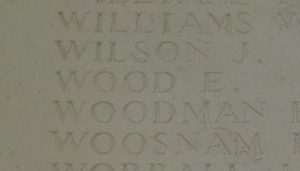
World War Two, 1939-1945
Jack Ernest Astley, Fusilier, 4195064, Royal Welch Fusiliers. Jack was the son of Edmund Astley and Frances Alice Astley (nee Blower), of Golfa. Both his parents had been married before, and been widowed. His mother’s first husband, William Pryce Astley, no relation to her second husband, had been killed in WW1. Jack enlisted into the 10th Battalion, Royal Welch Fusiliers soon after the outbreak of war. The battalion was a second line TA unit, attached to the 38th (Welsh) Division, and was used for training troops ready to send them to front line units, as well as playing an important role on home defence, but in 1942 was converted into a Parachute Regiment battalion. Jack died on home service on 8 February 1940, aged 20. His remains were brought home for burial in St. Cynyw’s Churchyard, Llangyniew.
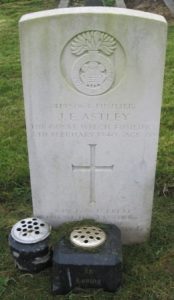
David Glyn Davies, Private, 11062860, Pioneer Corps. David was the son of David Davies, and of Gwladys Davies (nee Gittins), of Llangyniew. He enlisted into the army and was posted to the Pioneer Corps. David died in Shrewsbury Hospital on 18 February 1945, aged 22. His remains were brought home for burial in St. Cynyw’s Churchyard, Llangyniew.
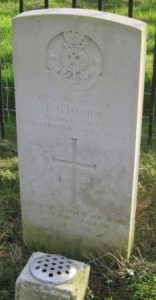
Abram Jones, Serjeant, 7522728, Royal Army Medical Corps. Abram was born on 23 March 1914, the son of John Jones and Emma Jones. By 1939 the family was residing at 9, Upper Church Street, Oswestry, where Abram worked as a manager in a shoe shop. He married Edith Foulkes, of Cyfronydd, Llangyniew in 1940. Abram enlisted into the army and was posted to the Royal Army Medical Corps. He died in Wrexham on 2 October 1944, aged 30. His remains were brought home for burial in St. Cynyw’s Churchyard, Llangyniew.
